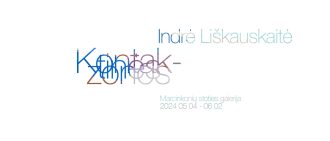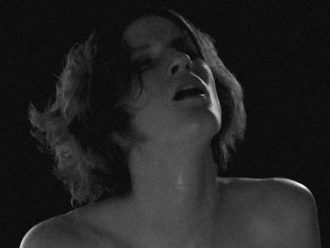WT Foundation presents ‘Стрілецька’ a solo exhibition of new paintings by Rute Merk opening June 4th.
Identification conflicts with the contemporary objects refracting into apparently infinite copies. Touching the Real is presently inconceivable. With this in mind, Rute Merk’s suite of paintings in ‘Стрілецька’ is an ontological call to action. One sees ungrounded representations of ergonomic seating, Kendall Jenner’s doberman, and chimerical depictions of long, shiny hair. Her ensemble of deities and artifacts are gathered here to present the viewer with a reclusive feminine exaltation. These hyperimages supersede the particular and settle into the same sort of non-space occupied by the digital.
The familiar figure in Kenda rewards a ‘good boy’ by kneeling and reaching out to the hound. Jenner is made the matron saint of Dogville. The off-duty model dons an athleisure fit popularized by brands like Yeezy. Here the reference is a ‘flicking off’ of sorts, as the artist pushes against the commodification olympics generated by capital – casting a gesture unceremoniously to a more intimate virtual identification with net aesthetics and a certain fixation on doomscrolling; a nightscape catenated with the blur of digital artifacts – an algorithmic Laocoön – carries the point home. Recently, she has noted that this engine for mean world syndrome has become the collectivize retreat for confined citizens of the world where options are limited to an advanced, domesticated consumption of cultural objects. For many, this means that the scroll has become unbounded by time or practical constraints, and manic research has devolved into excessive absorption of negative information. Cosm is appropriately steeped in a saturnine cosmos, one where an uncanny alienation infects a canvas sputtering with cool-toned vicissitudes. There is a voicelessness of images. Though they radiate an ambient Burial-esque freezing of the present in an attempt to conceive of both the past and the future. This is where Merk’s historic dexterity exhumes palatial signifiers while simultaneously bracing for an untenable tomorrow.
Mood reigns supreme in Merk’s paintings. Clarification is not impossible. In fact, the distant human features point towards an unnerving placidity, much like the hedonic aristocracy, as expressed by the earlier masters Fragonard, van Dyck, and Boucher. Such opulent portrayals of the well-to-do were commissioned in order to affirm and reproduce structures of power, while also making their subjects immune to mortality. How does the contemporary artist’s advanced agency factor into portraying the banal? The effect of this indulgent spirit is now more perverse. The apparent end of history is yet another relatively new confrontation. A slowing of pace appears sacrilege in such a frenetic, productive universe where comfort is the ultimate luxury.
Merk indulges in the opportunity to engage with this algorithmic stuplimity, and she effectively subverts the ‘negative’ by confronting the potential of these territories. Her paintings zone and zoom into a sub-, or, perhaps-, pre-reality. She paints space first, then whirls floating signifiers into the void. Her work disrupts the process of meaning-making by reverting back to the self as arbiter of the Real. Are these objects and symbols yours or mine? Hers, or ‘belonging’ to some other unknown party? What is highly personal for one becomes highly impersonal for another. She further subsumes the Aquinian logic of one’s objects of desire comprising and defining a self, providing some stability in the matrix of individuation. Merk’s game of semiotics finds its bread and butter in an idiosyncratic recombination of parts. The art getting done here produces this mess of significations, an ultimate confusion of hierarchy.
She impresses hyperactive infinitudes onto large canvases that find static in objects and people. Details are always a bit fuzzy, much like a partially loaded webpage or a low-resolution rendering. They traffic in the bait-and-switch frisson of their likely misperception as digital prints, muddling the parameters of time, singularity, and value in the process. Hers is an analogue facsimile of their origin and obverse: reproductions.
These paintings confront banality by confusing the logic of futures. Perhaps the worst-case scenario is not a dystopia, but an advanced culture shot through with apathy and malaise. Following this line of thought, Merk’s indulgence in figuration dodges cynicism by posing alternatives to inelastic doomsday hypotheticals. Investing in these images, the viewer experiences a rapid ease into some sort of future tense. Though, what do we wish to see when we get there? It is impossible to live a life unaffected by objects as guides through and around ideologies.
Merk’s process disrupts the purely representational by engaging with pattern-making. This methodology compounds the artist’s relationship to technology vis-à-vis mimetic gestures, as illustrated by an incredibly idiosyncratic repetition of forms, colors, and subjects. She is equally adept manipulating the idioms of avatar renders as she is parodying the codified painterly genres of still life and portraiture. In her newest paintings, she also expresses a relationship with hair and the cultural history of hair-as-identification. Here, she objectifies it, displacing its growth from the realm of discourse into the hands of the voyeur. In this way she apparently trusts her audience to do work by way of decodification. With Zilvile, one may be drawn back to the little girl on the cover of The Future Sound of London’s 1994 record Lifeforms. The girl, in her numerous iterations for the album art, is untethered to the purely digital or the corporeal and, instead, is suspended in an ambiguous non-space that Merk occupies in her practice. The fact that I can’t fully detect a familiar eyes-nose-mouth configuration is one of the charms of these feminine figures. I wonder: is this someone I should know? Or, is the inability to recognize double-linked to the rampant obfuscation of truth and fact in politics and the media? How does painting reify or credentialize identity? Is this instead an effort to come into contact with a totalizing sublime?
It should be underscored that the purely visual form of mimesis forms a one-to-one replica of the subject. Merk doesn’t do this. Instead, she imitates by way of feeling rather than looking. Sir Joshua Reynolds suggests the artistic Genius renders nature by referring ‘for its truth to the sensations of the mind’ rather than optics. Naomi Schor cites a marked schism in Reynold’s logic: he oscillates between a ‘strict anti detailism’ and ‘a lucid recognition of the uses of particularity in keeping with the contemporary rise of realism.’ It is crucial that Merk occupies this liminal space that exists at the intersection of technological mimesis and the sublimity of totalization. Returning to Kenda, one becomes aware of the subject’s specific identity only by regarding the title as well as the dog, then piecing together these indicators.
These dreamlike imaginaries shuttle from a wraithlike austerity to ecstasies of tie dye liquidity – vast and varied backdrops serving to foreground compressions between the corporeal and electronic. Merk is keen to document the politics of tech, aligning herself with what she calls the ‘transport, currency and reflection of mediations we are constantly exposing ourselves to: information, fashion, technology, society.’ Linet, a dark evocation of a woman basked in deep space, is another proposition in the cool hedonic measure of Merk’s surreal defamiliarizations. This avatar portrait is afflicted by the patterned background and thus subsumed in the painting’s mirage.
The ersatz representation of a female subject is punctuated by an extreme languorousness and business casual attire – emanating vertigo at the meeting of labor and leisure. Semiological associations with Cosm are underscored by such vestiges of bureaucratic ephemera. Entering WT Foundation, it is clear that we are bearing witness to Merk’s trance-like mindscape – one preoccupied with traces, fissures, and a curious assertion of an art epochal renaissance steeped in the energy of virtual obscurement.
Text: Reilly Davidson
Rute Merk (b. 1991, Lithuania; lives and works in Berlin) received her BA in Painting from Vilnius Academy of Arts in 2013, and is acquiring her painting diploma at Akademie der Bildenden Künste, Munich. Solo exhibitions: Downs & Ross, New York; Gallery Vacancy, Shanghai; Vent Gallery, Vienna; Editorial, Vilnius. Selected group exhibitions: Kunstverein Munchen, Munich; Marburger Kunstverein, Marburg; Rupert, Vilnius; Contemporary Art Centre (CAC) Vilnius, Vilnius; 427 Gallery, Riga; Vartai Gallery, Vilnius; Art Hall, Talinn; Tate, Liverpool; Malmö Konsthall, Malmö.
Location: WT Foundation, улиця Стрілецька, 4-6, Київ, 02000.
Duration: June 04 – August 01, 2021
Photos: Maksym Bilousov.










































